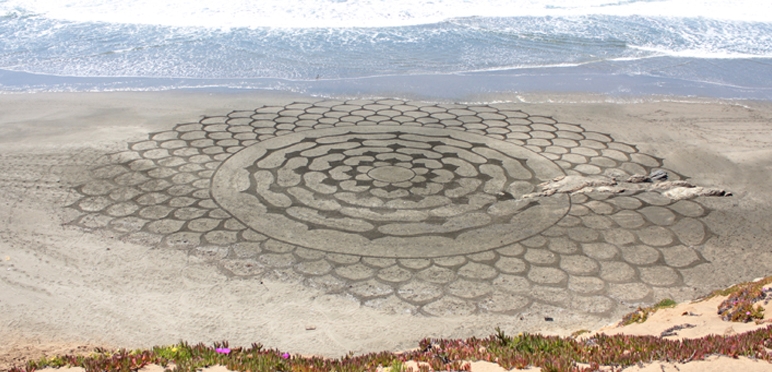Andres Amador (San Francisco)
Playa Paintings for World Peace: Artist Andres Amador wears International Peace Belt
On April 28, at 7 am, artist Andres Amador stood on the Thornton Beach, just south of San Francisco, wearing the International Peace belt and meditating for peace.
He was about to begin one of his Playa Paintings, detailed geometric drawings in the sand that lingers only as long as the tide allows. The meditation was part of the protocol for all who wear the International Peace Belt, an intricate piece of art designed and created by Middletown-based artist Wendy Black-Nasta, founder and executive director of Artists for World Peace (AFWP). She and her jewelry interns crafted it in 2003 out of tiny links of sterling silver, precious and semi-precious stones from around the world, and coins from all different countries.
Artists—musicians, dancers, painters—and internationally acclaimed ambassadors of peace fasten the luminous links around their waist or drape it over their shoulders, meditate or pray, as their spiritual connections urge them, and then begin creating their work of art dedicated to world peace. As of this writing, the International Peace Belt has traveled to 28 countries. Its journeys are documented in photographs and will be housed at the Smithsonian when it completes its world travel.
That morning, six other people joined Amador in his meditation: his partner Ember, with their son Kavi on her back, two members of Andres’s team—a photographer and a drone operator to capture aerial views—and Connecticut native Michele Wytas, a member of AFWP, and Lisa Murphy, a childhood friend with whom Wytas had recently reconnected.
Wytas was attending as the belt’s caretaker, a role she’d undertaken three times before, twice carrying the belt with her to her ancestral village in the Czech Republic, and once to Dubai.
While those trips were important to Wytas, the trip to reconnect with her friend and bring the belt to Amador was unique. “There is something special—a vastness—about being near the ocean with the Peace Belt,” she notes. “You realize that there’s a bigger picture, some energy that connects us all.”
Amador begins the task of playa (Spanish for “beach”) paintings, making uniform circles by extending his arm from the end of the rake. Ember then marks points along these circles as guides for his design.
Once the complete pattern is laid out, Amador begins the shading process and invited Wytas and Murphy to assist, adding repetitive strokes that brought it into a three-dimensional appearance.
As time passed—two hours before the mandala-like artwork was complete—others wandering the beach stopped by to watch and wonder: a couple on horseback, a number of people walking dogs, some parasailers and hang-gliders.
Overhead, the drone buzzed by, garnering a bird’s eye view to share later on both Artists for World Peace and Andres’s FaceBook page.
“At the end we all stood together again in that same center circle,” recalls Wytas. “Andres asked us to say what we were thankful for and to meditate once again on giving peace to the world.”
Hiking up the cliffs afterwards brought Wytas a larger perspective on the art and the meaning. “From above, I could see the breathtaking grandness of Andres’s work. The tide was already beginning to come in and the waves rolled over just the edge. It wasn’t even sad to watch it go, now that I understood: He’s sending it out for the world, all the energy of the labor, the art, the meditations on peace. The ocean is carrying all of that, spreading it to the rest of the world.”
Afterward Amador, too, reflected on the experience of making his art in the International Peace Belt. “The visceral feeling of the belt on my body was a grounding force– the weight, the swaying of the strands, the jingling of the coins and links. I was always aware of its presence, always brought back to my intentions for the artwork of sending the energy of harmony into the world.
“It is a tremendous honor to have added my voice and energy to the Peace Belt.”
Photos by: S. Smith Patrick and Michele Wytas
Visit Andres Amador at: www.andresamadorarts.com









